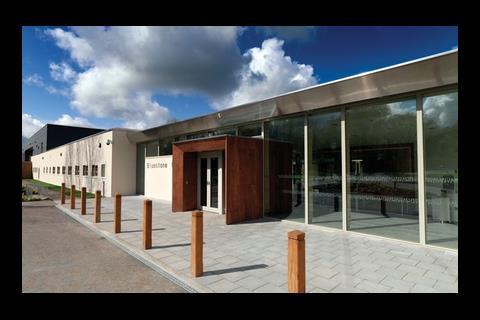The Department of Health is encouraging mental health trusts to invest in well-designed, user-friendly facilities for their patients. Emily Wright looks at the construction opportunities in this specialist market
Walking around Horton Haven Villas on a bright summer’s day, everything appears perfectly normal. The red brick buildings are covered in creeping ivy, flagstone pathways weave in and out of flower-laden gazebos and people mill around talking and enjoying the sun. On closer inspection, however, all is not as it seems. A 3m-high fence runs around the facility, the entrances to the villas are secured with an airlock system and surveillance cameras and video entry phones are fitted to every door.
This is Horton Haven, in Epsom, Surrey, one of a new wave of mental health facilities that adopt a domesticated approach to rehabilitation. The high levels of security, though strictly adhered to, are far more discreet in these modern “health villages” than in traditional mental hospitals.
Changing attitudes towards mental health and improved medication have made the Victorian approach to mental illness obsolete. The Department of Health (DoH) and NHS trusts are joining forces with contractors and consultants to deliver facilities through PFI schemes and healthcare frameworks.
A report released by the DoH in December looked at how mental health commissioning should be changed, and gave guidance on everything from procurement and design to building the facilities. Medical professionals and healthcare specialists predict that as NHS trusts respond by applying for funding to update their services, there will be a wave of demand for healthcare project. Eighty-three mental health project worth more than £280m were procured in the first quarter of 2009, and a £2.9bn framework for delivering healthcare facilities is to be launched in 2010.
Firms looking to position themselves for this work will need to know where it is, what is required to deliver it and how they can win the contracts. ∫√…´œ»…˙TV visited the sites leading the way in mental health development and spoke to clients, consultants and architects with experience in the field.
Why now?
A shift away from Victorian asylums to care in the community in the eighties led to very different outcomes for patients; some were successfully helped by the private sector, whereas others were left untreated and even wound up in prison. But plans are now in place to reintroduce as many sufferers as possible to care systems in the public sector.
“Up until now, mental health has been a bit like the Cinderella service,” says Ian Greggor, a project manager at Cyril Sweett who specialises in mental health. “Investment has traditionally been poor but in the past two years there has been a change. There is now more of a focus on community care. Attitudes have changed, and now we need new buildings and renovations.”
This push for change is fully backed by the DoH report, which focuses on new design techniques. Peter Cameron, associate director at architect Broadway Malyan, which designed Horton Haven Villas, says: “The new design guide is much more about working with the philosophy of the client, so there are spaces that work for the end user – bright, open areas, and a complete move away from long corridors and wards.”
Investment and procurement
Although support for the changes is clear, questions remain about investment. Spending on mental health has increased by £1.7bn, or 44%, in the past six years, but there has been no national programme to fund the construction and improvement of facilities.
NHS trusts can apply for funding through PFI schemes. Frameworks include the Local Improvement Finance Trust (LIFT) scheme and Procure 21, a £2.4bn programme launched in September 2003. Between them they have been responsible for funding most projects, from the £4.1m Horton Haven scheme to health villages such as the £60m scheme won recently by Mace, in an undisclosed location.
The future for investment looks bright. From September 2010 an updated version of Procure 21 will be introduced to build NHS schemes – mainly hospitals and mental health units. Known as Procure 21+, it will be worth about £2.9bn and will be publicly funded.
To win a place on the framework firms must submit a prequalification questionnaire by 6 September. This will be issued on 4 August, tenders must be in by 14 December and a shortlist will be announced on 7 April next year, with appointments due on 26 April.
Challenges
The first problem facing these projects is securing planning permission. Greggor says local residents often need reassuring to prevent them delaying applications. “Public angst can make it hard to get planning so you need to get local residents on side.” Nevertheless, he says, a long period of public consultation should be expected.
Madeline Marjoram, project manager of the Horton Haven development for Central and North West London NHS Foundation Trust, organised an event at which the construction team met residents to talk through their concerns. “In the end most people were receptive, once they understood how it would work,” she says.
But residents are not the only obstacle to securing planning permission. “Because so many of these sorts of facilities are on old sites or are renovations, the planning officers are very strict. It can involve a long list of conditions such as maintaining original materials where possible,” says Marjoram.
Trickier still is the design of facilities. The main challenge is to ensure the product is safe for people who may use their surroundings to harm or kill themselves. “Patients can be extremely inventive,” says Marjoram. “Some are very clever when it comes to achieving the goal of killing themselves, so you need to cover all bases.”
There should be no exposed beams, or frames from which patients could hang themselves. Shower fixtures or door handles must be curved so that anything hooked over them slips off, and shower and curtain rails need to be collapsible under a certain weight.
Other measures include installing sinks with no plugs, the reinforcing of doors and walls and the specification of laminating windows and mirrors. Everything must be fixed to the floor, including wardrobes, desks and bedside tables, and doors should swing both ways to prevent barricading.
David Morley Architects in association with Hall Black Douglas has designed six mental healthcare buildings, including the Bluestone unit at Craigavon hospital in Northern Ireland that won mental health design award. David Morley says it is important to understand the thought processes of the patients. “Everything, down to the last screw, needs to be tamperproof – but they need to look normal,” he says.
He says the facilities, particularly the bedrooms, must be tested to ensure they are as safe as possible. “When we were building Craigavon, we built a mocked-up bedroom in the car park. Then we took a sledgehammer to it to make sure it was up to the job.”
Once construction has been completed, maintenance work must be given equally careful consideration. Pipe and cabling work need to be accessible, but not by patients, so they are often deeply embedded into walls or sheathed in steel.
Winning the work
Construction in this sector is so specialised that NHS trusts tend to be wary of taking on firms without past experience. “It’s not the type of building to learn on and there is concern from the client about potential pitfalls because the end user needs to be safe,” says Morley.
David Morley Architects’ success in securing its first mental health scheme, in 1993, has served it well. The contract was awarded on the understanding that if the design worked well the NHS trust would use the practice again on other projects.
However, there is room for new companies to break in, too. “It’s not true that if you don’t have experience, you can’t do a good job,” says Greggor. “But there is a delicate balance for clients between people they know and trust and seeing new blood.”
He advises firms with little or no experience to form partnerships with subcontractors that have mental health projects in their portfolio. He adds that trusts will be receptive to newcomers if they can demonstrate innovative ideas and an understanding of the end user.
“I’d suggest contacting NHS trusts after looking at their annual report and seeing which have plans and a budget for these sorts of projects,” he says. “Understand exactly what you want to achieve, who you are building this facility for and demonstrate that to the client. It takes a certain type of firm to be able to be as sensitive to the needs of the end user as is required in this sector.”
Top tips: How to win work in mental health
Duncan White has been the senior strategic health consultant for Mace for the past five years. Before that he was a mental health professional for 34 years and is a registered general and mental health nurse. He explains how construction firms should approach the sector.
How should firms ensure they are top of the pile when bidding for these projects?
By making sure designs and attitudes to the sector and construction of facilities are up to date. The industry should be looking to build health villages, not hospital-style buildings. And if the trust wants to stick to a ward format, flexibility should be built in by using demountable walls and spaces that can have than one purpose. Including this sort of thing will make winning bids.
How will changes in the sector affect the design and structure of facilities?
You can already see evidence that some NHS trusts realise what patients need. They are the ones where villas are being built and long corridors are being replaced by curves and decent spaces, such as Craigavon and Horton Haven (see images). But some trusts still want corridors and wards, which is so out of date. The low ceilings, bad light and long tunnels create a pressure-cooker feel – just the atmosphere you don’t want in a mental health institution.
So there will be a lot of work in the pipeline as trusts have their facilities rebuilt or renovated?
Yes, but I just don’t think there is any point in spending £50m on a ward facility that in 10 years’ time, thanks to medical progress, will no longer be needed. I think the construction industry can help make sure we move away from these facilities.
How can construction firms help?
By being innovative and persuading trusts that they need to futureproof their facility. They should also persuade trusts that the cost of demolishing an out-of-date facility may be as high as putting funds into building a new one full of demountable walls, communal space and individual bedrooms. The construction industry, especially architects and consultants, can show the medical team how things could be.
Downloads
Postscript
Original print headline: 'And not a cuckoo's nest in sight'































No comments yet